There’s both an art and science to learning how to name a blog that tells readers about who you are, the topics you’re blogging about, and more. So, what are you going to name your blog? Let’s dive into this ultimate guide, look at some blog name ideas and examples to inspire your decision.
How to Start a Blog (and Make Money) in 6 Easy Steps:
- Pick your blog's name and niche
- Get your blog online (Web Hosting)
- Design your blog with a free theme
- Write your first blog post
- Promote your blog and get readers
- Make money from your blog.
Follow these 6 steps to learn how to start a blog and make money today:
If you’re ready to take the leap and learn how to start a blog that can grow into a source of real online income, then let’s dive in.
1. Pick your blog’s name and niche
First, it’s time to pick a name and niche for your new blog.
The name of your blog is what readers will see first (like yourblog.com), so it should ideally represent either the general topics you’ll be writing about—or it could be your own name, that of your business, a clever combination of words, or otherwise.
Your blog’s niche is the general topic area that you’ll be focusing your content around. Examples include topics like travel, food, fashion, lifestyle, technology, and otherwise. Incorporating a word or two that clearly signals what your content is about, within the name of your blog (like fashionbyjane.com or watchryanhike.com)—will be very helpful for your future blog readers.
2. Get your blog online (web hosting)
The second step in starting a blog is actually getting your blog online. That’s what a web hosting company will do for you. In this step, you’ll be selecting the blogging platform and web hosting plan you’ll use to get your blog online.
The combination of blogging platform & web hosting I personally use (and that most other bloggers use) is a WordPress blog, hosted by Bluehost. WordPress is a free publishing platform that’s been around since 2003 and now powers more than 60% of all blogs on the Internet. Bluehost is one of the most established, reliable companies in the blog hosting industry. This combination is what we’ll be using to start your blog. Now, let’s get your hosting set up.
Pick your blog’s domain name
If your domain name of choice isn’t available, you can either try another option that comes to mind—or (what I recommend) select the option to choose your domain name later after getting the rest of your account squared away and taking a little more time to think the name through. Plus, later on down in this guide, I expand some more on how to choose the right name for your blog if you’re not decided yet.
Here’s where you can click to choose your domain later (it’s a popup that will appear if you hover on this page for long enough or move your mouse up toward the top of the page):
Create your Bluehost account
Start by filling in your account details like your name, email address (it’s super important to use an up-to-date email address because this is where your login details and account information will be sent), and address. If you don’t want to enter your information manually, you can connect your Bluehost account with your Google account. Either work!
Select the right hosting package
This is where you’ll choose an account plan based on the price you want to lock in and how far in advance you’ll pay.
Note that Bluehost only offers options for you to pay 1, 2, 3, or 5 years upfront. They don’t offer a monthly payment option (because most hosting companies that do offer monthly payments tend to charge a bit more). Even still, with whichever plan you choose, the price works out to be a great deal for starting your own blog and getting it online today.
Which pricing plan is best to start a blog with?
Personally, I recommend choosing the “Prime 36 Month Price” if you want to lock in the lowest possible price for your hosting. That’s what I use. And it secures your blog hosting at its lowest rate (and gets you domain privacy) for the next 3 years. And because this low pricing for new customers only applies to the first payment you make, if you were to choose the 1-year plan, your pricing may go up after that first year.
That’s why if you choose the 36-month plan, your pricing will be locked in at this rate for 3 years. For that reason, I recommend going with the longest duration plan that your budget can spring for.
3. Design your blog with a free WordPress theme

Now that we’ve gotten through the crucial setup phase of starting a blog, it’s time to have a little more fun.
Designing your WordPress blog is when you might start to feel a little friction with this process though (if you’ve never worked on a blog before), but I promise this won’t get too technical.
If you want to start a blog and make money from it, WordPress is your smartest option
Let’s cover some basic terminology, so you understand why WordPress is the right platform (also known as a Content Management System or CMS) to run your blog on.
- Is free to use (with heavy restrictions)
- Doesn’t let you pick a custom domain name (i.e. 👉 yoursite.wordpress.com)
- Has very limited monetization options (you can’t sell your own ads)
- Doesn’t let you upload plugins (for email capture and other things)
- Has limited theme support so you’re stuck with very basic designs
- You have to pay to remove WordPress branding and get your own domain like yoursite.com
- Limited SEO and analytics
4. Write your first blog post

You read a blog because you care about what it says. Creating strong content is what will bring you readers and help you to eventually make money blogging.
5. Now you’re ready to write your first blog post
Once you’ve decided on the first blog post you want to write, you’ll navigate to the “Add New Post” section from your WordPress Dashboard.
Go to Posts > Add New which will look like this right here:
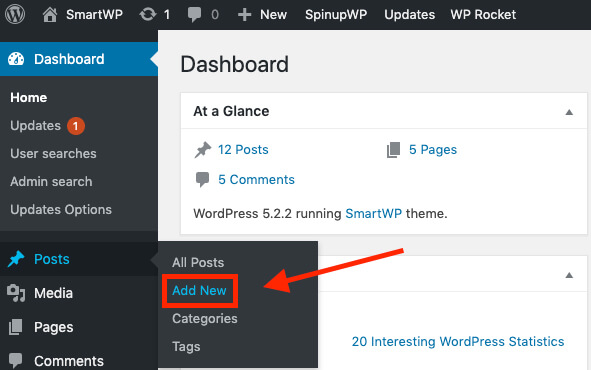
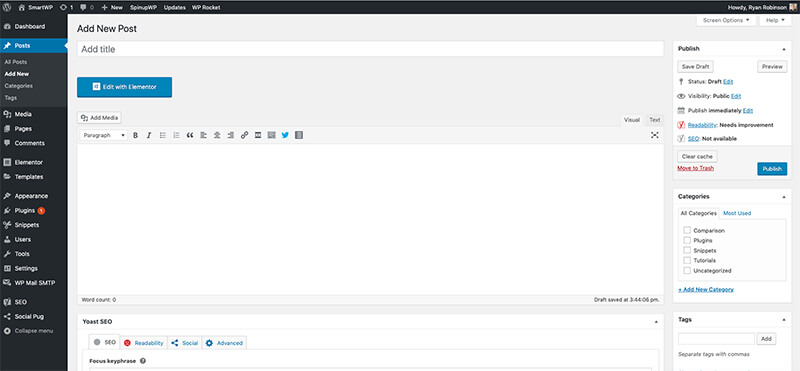
Writing a blog post headline that encourages readers to click through
One of the reasons you’re blogging is to attract readers, right? Well, it pays dividends to put some effort into learning how to write a headline that’ll entice readers and most importantly—deliver on the promise of what your article is actually helping readers to accomplish.
So let’s say you’ve determined that your hiking blog should start by breaking down some underrated hikes in Northern California. Next, click into the “Add title” bar on your new post page and type in a title like…
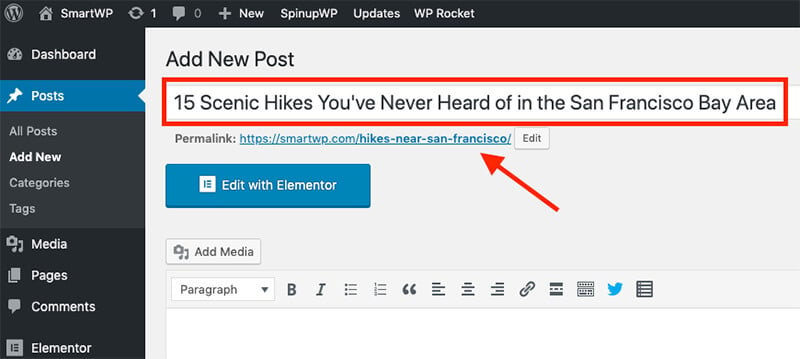
As a starting point to writing a strong title, learn by observing the headlines of other successful bloggers in your niche:
- Do they often lead with numbers?
- How many of their article headlines include parentheses?
- Does it seem like a best practice to capitalize the first letter of every word?
If you’re still unsure about how to title a new post, then do a Google search for the target keyword phrase you’re going after and gather inspiration for the ways other titles are written—be sure not to directly copy other bloggers, but that’ll point you in the right direction.
Choosing an SEO-friendly blog post URL
You must customize the URL of your new post if you hope for it to rank well in organic Google search results.
Crafting a compelling introduction to your new blog post
You have one or two sentences to convince readers your new post is worth their time. Here’s a sample blog post introduction I just wrote in less than two minutes for our hiking example:
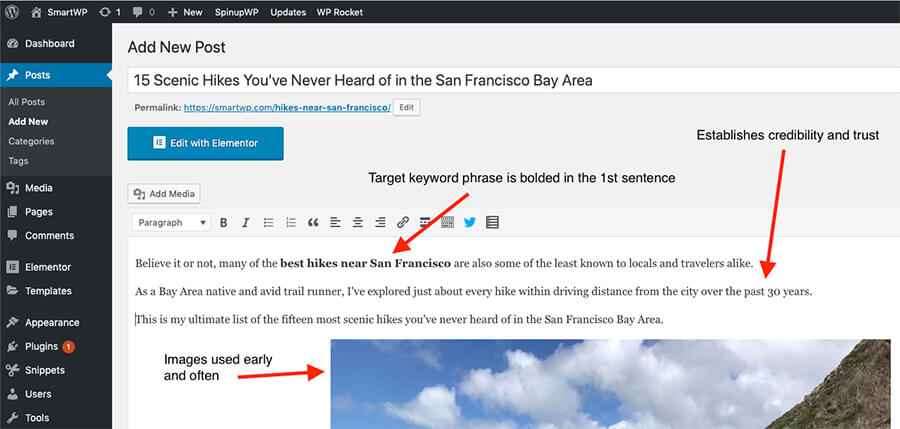
As you’re learning to write a blog post that keeps readers engaged, here are a few do’s and don’ts for crafting a strong introduction.
The easiest strategy for writing a compelling introduction is to answer the who, what, where, when, and why as soon as possible. This may sound counterintuitive, but another trick is to start with your conclusion first. In the age of short attention spans, people have grown tired of wasting time on clickbait blog posts that go nowhere.
The quicker you can establish relevance to your reader, give them a strong reason to believe they’ll find what they’re looking for in your blog post, the more likely they’ll be to dig into your piece and share with others.
Optimizing the design and layout of your blog post
Ultimately, what looks “good” is subjective and up to you, based on what you think your (future) readers will resonate with most. But one of the most important lessons I’ve learned through starting a blog of my own is that design matters a lot.
These five time-tested design principles will be immensely helpful in constructing an appealing blog layout (that’s easy for readers to digest).
Hitting publish on your first blog post
Once you’ve written your first blog post (and ideally get it to the 1,000+ word range) you’re almost ready to publish!
Take a few minutes to double-check on the Yoast SEO suggestions and ensure your blog post is SEO-friendly, which will give you the best chance of ranking well in organic search.
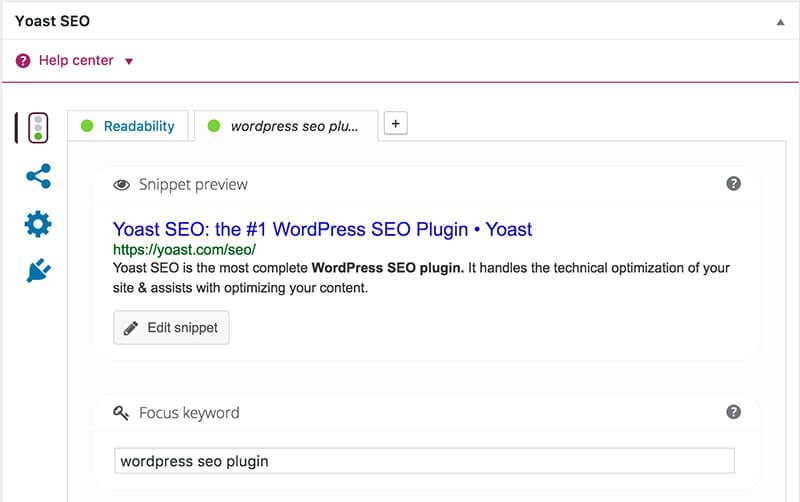
After your SEO settings are dialed in, choose which “Category” this new post will fall under and tick that box. Then, you’re ready to hit publish!
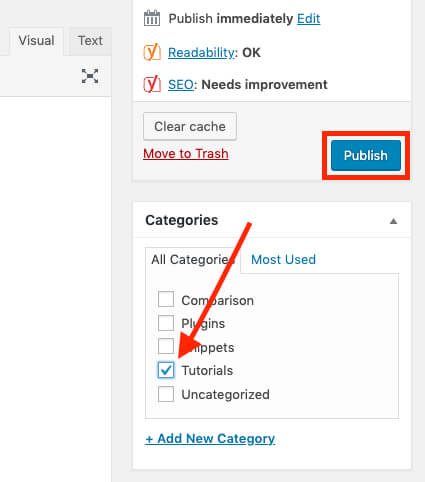
And boom! It’s that easy if you allow it to be 🎉
Now, if like me, you appreciate great design—before you hit publish on your first blog post, there’s one last step you could take.
Studies show that blog posts with images get 94% more views than those without. And when it comes to posts getting shared on social media, tweets with photos get 150% more retweets than those without one, while Facebook posts with images get 2.3X more engagement. Adding a few visual elements can almost double your amount of views and expand the shares a blog post gets.
Free blog photo resources
One of the easiest ways to add some visual flair to your blog posts is with beautiful images and designs. Thankfully in recent years, there are now a number of high-quality sites that offer incredible photography that’s completely free to use for your blog—my favorite is Unsplash:
Unsplash (for free blog images and stock photos)
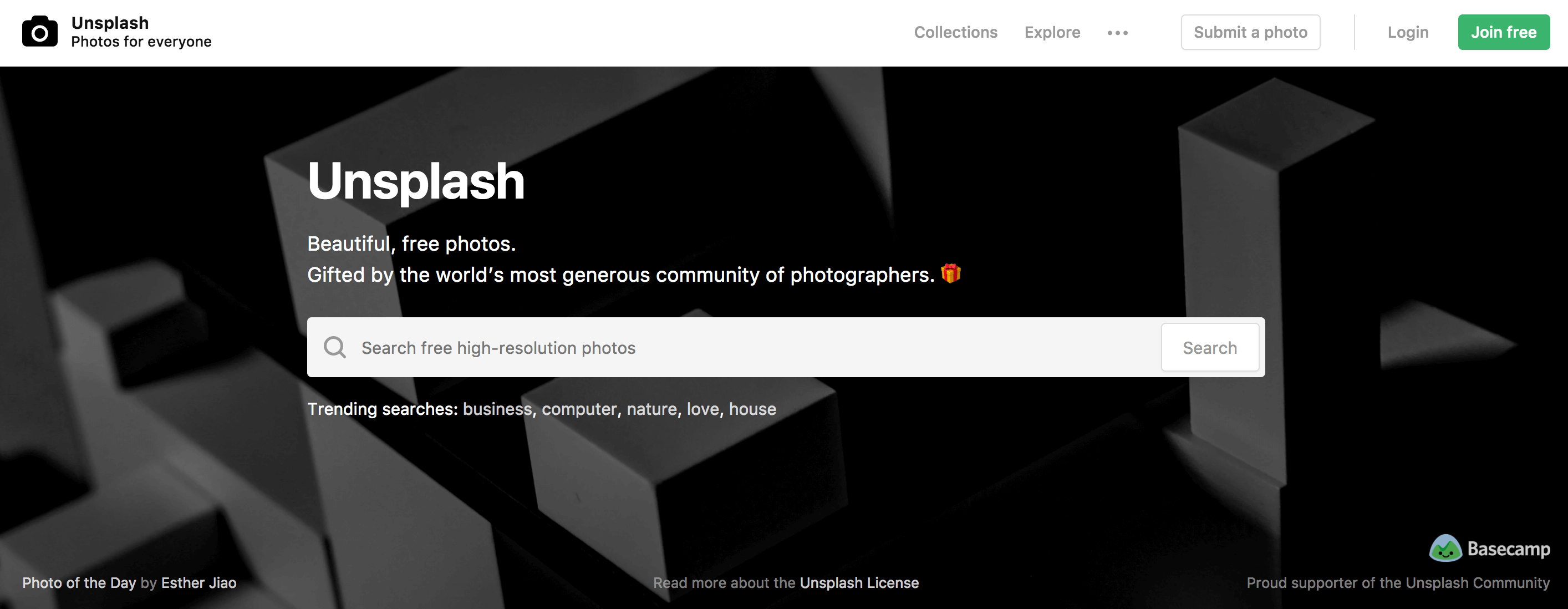
Unsplash is the best online resource for completely free, user-uploaded photos for your blog. Every photo that makes it onto Unsplash is curated by their team to make sure it’s high quality. Under the Unsplash license, you don’t even have to attribute the photographer (however, they recommend you do), which makes Unsplash the easiest option for free blog photography.
Other great free blog photo resources worth mentioning
- Wikimedia Commons: 21+ million photos and images from throughout history that is now in the public domain and free to use.
- Life of Pix: Awesome free-to-use photos donated by an advertising agency in Montreal, Canada.
Bonus: Creating a blog content strategy
I’ve been lucky enough to work for some fantastic companies and get paid to learn about the importance of having a content strategy for your blog. I’ve successfully applied those same lessons to my own blog—making many tweaks and additions along the way. And if you’re having trouble with your content planning efforts, grab my free blog planner bundle and turn things up a notch today.
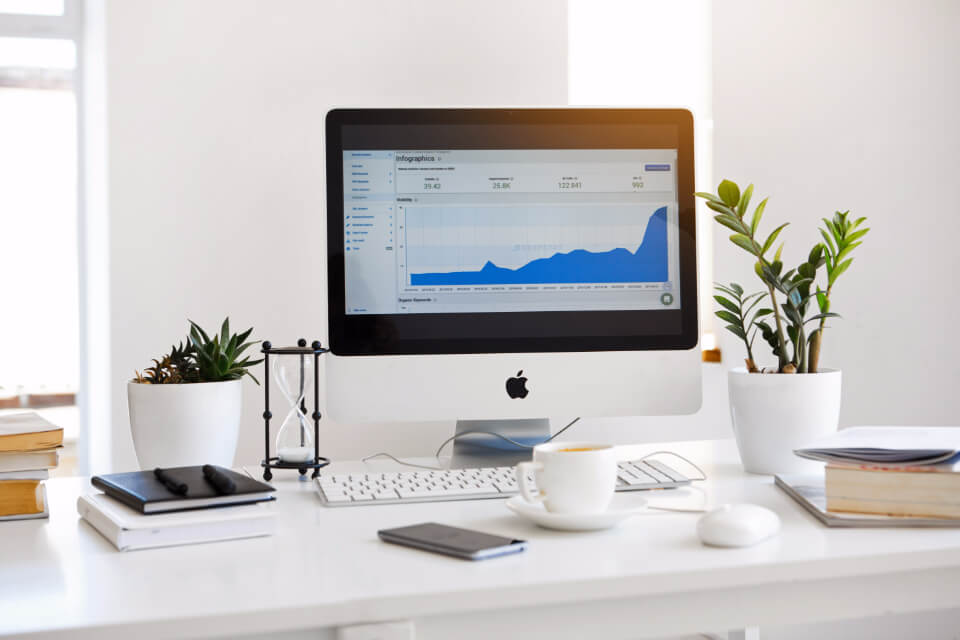
Here’s how to create a basic blog content strategy today:
- Define your blog goals: What’s your purpose for starting a blog? What do you want to achieve with your blog content? This goal might change as you grow your blog, but it’s still important to know it early on.
- Get to know your blog readers (and where they hang out): Your readers will determine whether or not your blog becomes successful. To write for them, you need to really understand them—which is why it helps if you’re also writing for yourself. It’s useful to do some research around the audience you’re writing for. Think about the demographics and psychographics of your target audience. Demographics are the quantitative traits of your readers (age, gender, location, job title) and psychographics are the more unmeasurable traits like values, interests, attitudes, and belief systems. Once you’ve written down these qualities, you can start to come up with an audience persona—a fictionalized version of your ideal reader.
- Decide on your blog’s main content pillars: When it comes to deciding what you’re going to write about, it’s good to have a few guiding categories that you’ll refer back to. I like to call these content pillars, as they’re the foundation that holds up the rest of your blog. For example, if you’re starting a blog about personal finance, your pillars might be: personal finance tips, interviews with experts, industry news, paying off debt, or otherwise. Each of these pillars can have hundreds of blog posts written under them. They also all work together to show that you’re a thought leader in your niche.
- Map out the content you’re going to create soon after starting your blog: Shortly after launching your blog, it’s worth taking a little time to plan out your content pipeline for the coming weeks (possibly months). You never know when your first blog post might go viral. In that case, you’ll want to have at least a game plan to quickly engage the new readers you get. Even just one or two blog posts under each of your major content pillars are enough to start with, ideally in the form of evergreen content that’ll stand the test of time.
How to Start a Blog in 2021: Final Takeaways for New Bloggers
Ultimately, growing a successful blog all boils down to being excited and engaged with your new blog. If you want people to read what you’re writing, you need to give them a reason to.
Write exciting content, connect with people in your niche and enthusiastically share what you’re working on.
The traffic, monetization, and everything else will follow.
I wrote this guide because starting a blog has been one of the most empowering, life-changing decisions I’ve made in my life.
And I hope that by now you feel confident enough to go out there and start a blog of your own.
I’d love to have you in my free 7-day course that expands on the teachings of this guide. We also dive even further into topics like driving traffic, my personal writing process, monetizing your blog, and more.
Infographic: How to Start a Blog (for Profit) This Year
For those more visual learners, I also put together this infographic breaking down the process of starting a blog—and my personal experience generating both traffic and revenue from your blog. Enjoy!

As this was a full summary or like a course for everyone, who is gonna starting a blog these days.


